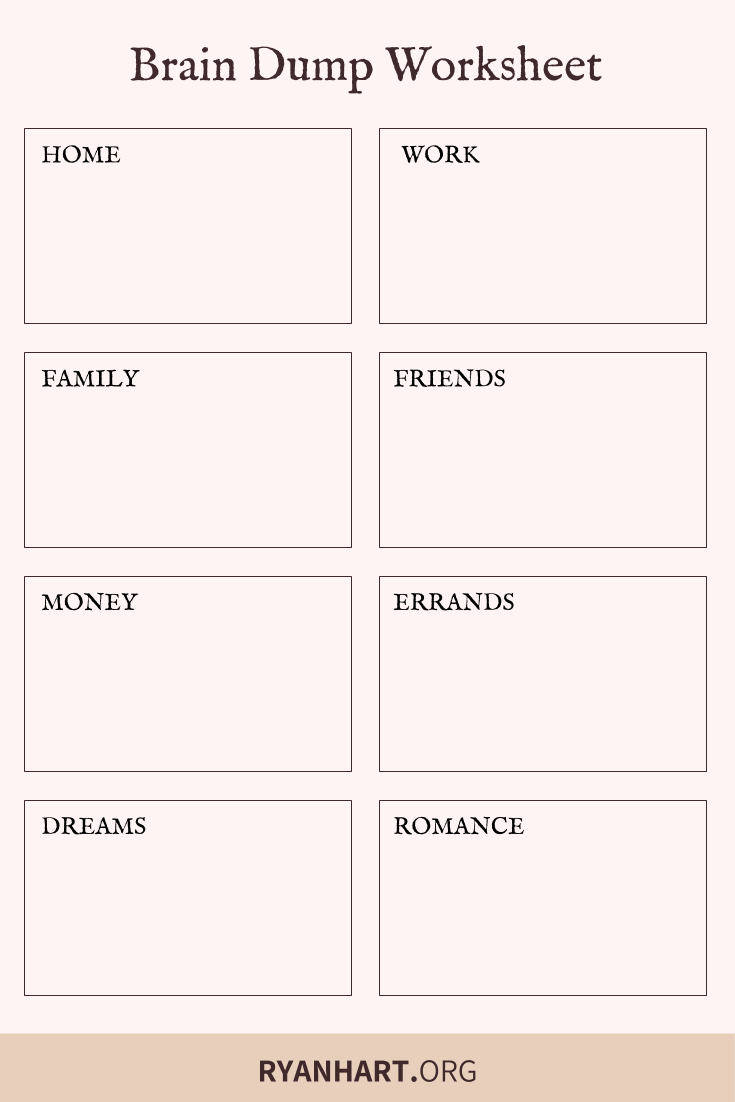3 Benefits of Using Brain Dumps to Reduce Stress
by Ryan Hart | Updated on February 27, 2019 | Post may contain affiliate links. As an Amazon Associate we earn from qualifying purchases.

In this post, you’ll discover the benefits of a brain dump and how to add it to your weekly planning routine.
In fact:
After using the brain dump method I was instantly able to organize my thoughts, reduce overwhelm, be more productive, and less forgetful.
Ready to learn how to brain dump?
Let’s get started!
What is a Brain Dump?
A brain dump is a simple process of taking all of the thoughts running around in your head and recording them in one place.
You can use a brain dump for multiple purposes including studying for tests, learning a new skill or organize your to-do list. The main objective is to organize your knowledge in one single spot for future reference.
The most common way I use a brain dump is to plan my week and create to-do lists.
Writing down the tasks that constantly fill my thoughts has been an effective way to make sure I don’t forget anything important. Also, just the act of writing down my thoughts makes them less overwhelming and easier to manage.
When I write down my to-do list, all of a sudden it clears up space in my brain and immediately reduces stress. With my entire to-do list is on a single piece of paper, it begins to feel more manageable.

How to Brain Dump (with Examples)
You can perform a brain dump at a specific time each day or week. For instance, I like to perform a brain dump at the end of the week to keep track of the tasks that did not get completed on my to do list, as well as plan for upcoming projects.
I also like to keep my brain dump notebook next to my bed so I can write down any thoughts that pop into my head before I go to sleep. I’ve found that writing down these thoughts helps me sleep better at night and rest easier knowing that I didn’t forget anything important when I wake up in the morning.
Now that you know when and where you will complete your brain dump, let’s learn how to do it effectively.
Step 1: Grab Your Supplies
Brain dumping requires very few supplies. All you need is a pen or pencil and a blank piece of paper. However, to make the most of my brain dump session I like to take it one step further.
I find it helpful to use different colored pens or markers to categorize my tasks. I also like to have several blank pages handy as my brain dump expands. And finally, I always have my weekly planner next to me so I can schedule any upcoming appointments and tasks I identify during my brain dump.
When I first started doing brain dumps more frequently, I noticed my to-do lists began to pile up on my desk and I often misplaced previous brain dumps that had important tasks on them.
To eliminate these problems, I decided to buy a simple lined notebook that was dedicated to all of my brain dumps. Now, I never lose track of my to-do lists and can review my previous brainstorming sessions in one notebook.
So, before you begin your brain dump, make sure you have pens, paper or notebook, and your weekly planner ready to go.
Step 2: Write Everything Down
A brain dump is a quick and dirty way to instantly reduce stress or anxiety. To do it effectively you need to write down every thought or task that is floating around in your brain, as fast as you can.
Do not organize your thoughts as you write them down or edit which items make the list. The number one rule is to write absolutely everything down. Trust me, it will feel amazing when you do.
If you are feeling stressed, write down everything that is bothering you. You can also use brain dumping to record your thoughts on a certain topic such as work tasks, dinner ideas, chores, life goals, etc.
Students can use brain dumping to study for an upcoming test or quiz. Write down all of the facts you can remember about a topic which are relevant to your test. These don’t need to be full sentences or detailed descriptions but can be simple bullet points or keywords that help you quickly remember the material.
Step 3: Organize Tasks by Category
Now that you have everything out of your head and on to paper, it’s time to get organized.
I recommend grabbing another piece of paper or turning to the next page in your notebook. Create boxes for categories of tasks you wrote down during your brain dump.
Some of the categories I use frequently include:
- Work Tasks and Meetings
- Upcoming Appointments
- Home Maintenance Projects
- Weekly Chores
- Future Goals
Other common categories could include kids, hobbies, school or church activities, social events, community service, self-care, vacations, etc.
You could also organize your tasks into date-based categories such as by day, week, month or year.
I like to assign a color to each category so it’s easy to visualize which tasks belong where. If you want to keep your brain dump simple, that’s okay too. However, studies show that our brains process visuals like colors and images 60,000 times faster than just text!
Now, work through your brain dump list and transfer each item to its corresponding category.
After each item has been transferred it will be easy to see which tasks are causing you the most stress and which categories consume most of your time.
Once all of your items are categorized, let’s look at each task more closely.
Step 4: Break Big Tasks into Smaller Pieces
After you complete your brain dump, you may notice items on your list that you’ve been thinking about for weeks, months or even years! The reason these tasks have yet to be completed is probably that they are not very well defined.
For instance, one item that had been on my brain dump list for a long time was “get in shape.” Obviously, there are many ways I could get in shape, including running, riding my bike or lifting weights. But since I hadn’t specifically picked one, it just remained on my to-do list without any progress.
To start taking action on your to-do list and eliminate procrastination you need to break down your big tasks into smaller, more manageable pieces. For instance, I decided to start riding my bike one day per week and lift weights on two other days. These are actionable tasks I can schedule on my calendar and complete each week toward my goal of “getting in shape.”
What tasks have been on your to-do list for a long time? Break them down into the smallest tasks that will lead to progress toward your goal. Add these tasks to your brain dump.
Step 5: Use the 2-minute Rule to Get More Done
Now that you have your brain dump organized, it might be overwhelming to see the amount of stuff you need to get done. I know every time I finish my brain dump it seems impossible to complete everything I wrote down.
I’ve found that the easiest way to start making progress is to use the 2-minute rule. David Allen, the author of Getting Things Done, suggests looking at your to-do list and immediately doing the items that will take less than 2-minutes.
These could be sending an email, making a quick phone call or taking out the trash. Get the easy stuff off your list first and start building some momentum.
However, don’t make the mistake of only working on 2-minute tasks. It is easy to start a 2-minute task, get distracted, then find yourself wondering where the time went. Use the 2-minute rule to get momentum, but don’t let it distract you from completing the more time-consuming tasks on your to-do list.
Step 6: Time Block Important Tasks
The final step in the brain dump process is to time block all of your tasks. Time blocking is the process of scheduling your tasks on your calendar for a specific day and time.
Studies have shown that by using “implementation intentions” productivity dramatically increases. For instance, if you specifically say when and where you plan to do something you have a 90 percent greater chance of success than if you don’t. That’s the power of time blocking!
To begin using time blocking, schedule 90 to 120 minutes on your calendar to complete a group of tasks on your to-do list. Then, honor this time block with the same amount of commitment as you would if it were a doctors appointment or client meeting.
If you want to get more done it less time, I suggest reading my Advanced Time Blocking Guide.
Step 7: Repeat!
The final step in the brain dump process is to repeat it regularly. Set aside time each day or once per week to brain dump your thoughts. The more often you do it, the better success you’ll have.
I’ve found that when I skip my weekly brain dump, I end up stressed and overwhelmed. But once I write down my thoughts I instantly feel more organized and productive.
The longer you go between brain dumps, the greater the chance you’ll forget an important task or appointment.
Brain Dump Benefits

As you can see, a brain dump is an important part of my weekly planning routine. I continue to do it each week because it offers many great benefits.
Here are the reasons I think everyone should practice brain dumping:
Organize Your Thoughts
A brain dump is an easy way to organize your thoughts on paper. When you spend the time to write everything you are thinking it is easy to notice patterns and problems.
It can also be a helpful tool when planning projects, outlining a presentation, or preparing to have a difficult conversation.
When your thoughts are on paper it is easy to move them around, edit, expand or simplify them. I find it’s easier to be more objective about my thoughts when I can read them out loud. Sometimes after I write down the big problems that are floating around in my head, I realize that I was just making a mountain out of a molehill.
Reduce Stress & Overwhelm
I’ve found that the thought of a project or tasks can be more overwhelming than the task itself.
For instance, if I need to have a difficult conversation with a client, I will probably think about it for days but not take any action because I worry about how uncomfortable it will be. On the other hand, if I write it down during a brain dump, I can schedule it and finally cross it off my to-do list.
Plus, once your thoughts are on paper, there’s this magical thing that happens where it seems to disappear from your thoughts for hours or days. It honestly feels like a weight has been lifted off my shoulders once I write down my thoughts.
If you often feel stressed or overwhelmed with your to-do list, I highly recommend using the brain dump method every week.
Be More Productive
One of the greatest brain dump benefits for me is being more productive. It feels amazing to cross items off my to-do list after they have been bouncing around in my head.
When I write down all of my tasks during a brain dump I can properly plan when and where I will complete them, as well as anticipate how long they will take to complete.
If you wish you were more productive, I would highly suggest trying the brain dump method.
Now It's Your Turn
And now I’d like to hear from you.
Are you going to try a brain dump?
What do you think will be the biggest benefit?
Either way, let me know by leaving a comment below right now.
This newsletter is not just good - it delivers the best relationship advice to your inbox every morning Join thousands of subscribers discovering how to stop chasing emotionally unavailable people and start attracting true love.
Don't miss the chance to add your name to the list before the next edition goes live. If you want to take advantage of this opportunity, simply click the below to access our secure sign-up page.
Try the Newsletter
Ryan Hart is a certified relationship coach and writer. His mission is to help make connections between people better, stronger, more meaningful, and longer lasting using technology.
Want to connect with Ryan? Click here to get his FREE daily dating advice newsletter
